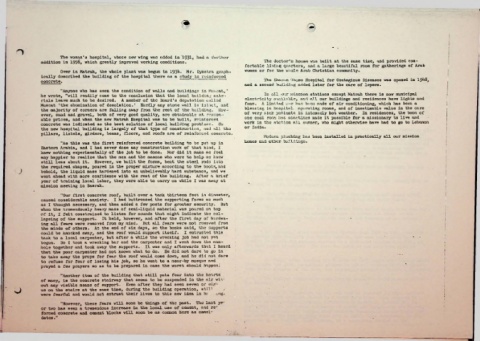Page 40 - History of Arabian Mission 1926-1957
P. 40
I
*
f
< J •
The woman's hospital, whose new wing was added in 1931, had a further
addition in 1956, which greatly Improved working conditions. The doctor'n house was built at the same time, and provided com
fortable living quarters, end a large beautiful room for gatherings of Arab 1
Over in Matroh, the whole plant was begun in 1934-. Mr. Dykstra graph women or for the whole Arab Christian community.
ically described the building of the hospital there as a study in reinforced \
concrete. The Sharon Thorns Hospital for Contagious Diseases was opened in 1948,
and a second building added luter for the care of lepers.
"Anyone who has seen the condition of walls and buildings in Muscat,"
he wrote, "will readily come to the conclusion that the local building mate- In call, our ro.Lsolon stations except Matrah there is now municipal
rials leave much to be desired. A member of the Board's deputation called electricity available, and ell our buildings and residences have lights and
Muscat 'the abomination of desolation.' Hardly any stone wall is intact, and fans. A limited use han been made of air conditioning, which has been a
the majority of corners are falling away from the rest of the building. How blessing in hospital, operating rooms, and of Inestimable value in the care
ever, sand and gravel, both of very good quality, are obtainable at reason of very sick patients In intensely hot weather. In residences, the boon of
able prices, and when the new Matroh Hospital was to be built, reinforced one cool room has sometimes made it possible for a missionary to live and
concrete was indicated as the best solution of local building problems. So work in the station all summer, who might otherwise have had to go to Lebanon
the new hospital building is largely of that type of cons traction, and all the or India.
pillars, lintels, girders, beams, floors, and roofs are of reinforced concrete*
Modern plumbing has been installed in practically all our mission
"As this was the first reinforced concrete building to be put up In homes and other buildings®
Eastern Arabia, and I had never done any construction work of that kind, I !
knew nothing experimentally of the Job to be done. Nor did It make me feel
any happier to realize that the men and the masons who were to help ine knew
still less about it. However, we built the forms, bent the steel rods into
the required shapes, poured in the proper mixture according to the books, and
' ) behold, the liquid mass hardened into an unbelievably hard substance, and we
went ahead with more confidence with the rest of the building. After a brief i
year of training local labor, they were able to carry on while I was away at
mission meeting in Basrah.
"Our first concrete roof, built over a tank thirteen feet in dimeter,
caused considerable anxiety. I had buttressed the supporting forms as much i
as I thought necessary, and then added a few posts for greater security. But ;
when the tranendously heavy mass of serai-liquid material was poured on top
of it, I felt constrained to listen for sounds that might indicate the ed
lapsing of the support, it held, however, and after the first day of haixlen-
ing all fears were ronoved from my mind, But all fears were not removed from
the minds of others. At the end of six days, so the books 6aid, the supports
could be knocked away, and the roof would support, itself, I entrusted this |
task to a local carpenter, but after a while the wrecking job had not yet i
begun. So I took a wrecking bar and the carpenter and I went down the man-
hole together and took away the supports, It was only afterwards that I heard
that the poor carpenter had not known what to do. He did not dare to go in
to take away the props for fear the roof would come down, and he did not dare
to refuse for fear of losing his job, so he went to a near-by mosque and
prayed a few prayers so as to be prepared in case the worst should happenI
"Another Item of the building that still puts fear into the hearts
of many, is the concrete stairway that seems to be suspended in the air wit5
out any visible means of support. Even after they had seen seven or
us on the stairs at the same time, during the building operation, st.ni
were fearful and would not entrust their lives to thi6 new idea in bu • • uig.
i >
"However, these fears will soon be things of the past, The last ye'-
or two seen a trenendous increase in the local use of cement, and re*
forced concrete and cement blocks will soon be as common here as camel'-
dates."

